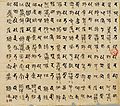Tantric yoga facts for kids
Tantra ( Sanskrit: तन्त्र, lit. 'expansion-device, salvation-spreader; loom, weave, warp') is an esoteric yogic tradition that developed on the Indian subcontinent from the middle of the 1st millennium CE onwards in both Hinduism and Buddhism.
The term tantra, in the Indian traditions, also means any systematic broadly applicable "text, theory, system, method, instrument, technique or practice". A key feature of these traditions is the use of mantras, and thus they are commonly referred to as Mantramārga ("Path of Mantra") in Hinduism or Mantrayāna ("Mantra Vehicle") and Guhyamantra ("Secret Mantra") in Buddhism.
In Buddhism, the Vajrayana traditions are known for tantric ideas and practices, which are based on Indian Buddhist Tantras. They include Indo-Tibetan Buddhism, Chinese Esoteric Buddhism, Japanese Shingon Buddhism and Nepalese Newar Buddhism. Although Southern Esoteric Buddhism does not directly reference the tantras, its practices and ideas parallel them.
Tantric Hindu and Buddhist traditions have also influenced other Eastern religious traditions such as Jainism, the Tibetan Bön tradition, Daoism, and the Japanese Shintō tradition.
Certain modes of non-Vedic worship such as Puja are considered tantric in their conception and rituals. Hindu temple building also generally conforms to the iconography of tantra. Hindu texts describing these topics are called Tantras, Āgamas or Samhitās. In Buddhism, tantra has influenced the art and iconography of Tibetan and East Asian Buddhism, as well as historic cave temples of India and the art of Southeast Asia.
Images for kids
-
A modern aghori with a skull-cup (Kapala). Their predecessors, the medieval Kapalikas ("Skull-men") were influential figures in the development of transgressive or "left hand" Shaiva tantra.
-
Illustration of a yogi and their chakras.
-
The Brihadishvara Temple, a Śaiva Siddhānta temple in Tamil Nadu
-
Śrī, also known as Lalitā Tripurasundarī ("beautiful in three worlds"), Adi Parashakti (the highest supreme energy), Kāmeśvarī (goddess of desire) and other names.
-
A Kali Puja (devotional ritual)
-
A Pujari in front of a Ganesha statue, Brihadishwara Shiva Temple
-
Sri Yantra diagram with the Ten Mahavidyas. The triangles represent Shiva and Shakti; the snake represents Spanda and Kundalini.
-
The Sri Yantra (shown here in the three-dimensional projection known as Sri Meru or Maha Meru, used primarily by Srividya Shakta sects).
















